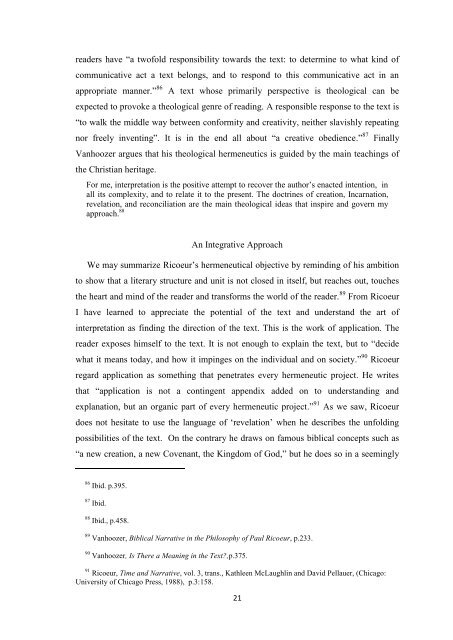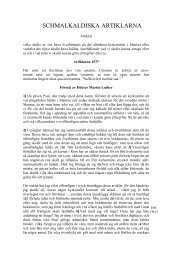MYSTERY REVEALED
MYSTERY REVEALED
MYSTERY REVEALED
You also want an ePaper? Increase the reach of your titles
YUMPU automatically turns print PDFs into web optimized ePapers that Google loves.
eaders have “a twofold responsibility towards the text: to determine to what kind of<br />
communicative act a text belongs, and to respond to this communicative act in an<br />
appropriate manner.” 86 A text whose primarily perspective is theological can be<br />
expected to provoke a theological genre of reading. A responsible response to the text is<br />
“to walk the middle way between conformity and creativity, neither slavishly repeating<br />
nor freely inventing”. It is in the end all about “a creative obedience.” 87 Finally<br />
Vanhoozer argues that his theological hermeneutics is guided by the main teachings of<br />
the Christian heritage.<br />
For me, interpretation is the positive attempt to recover the author’s enacted intention, in<br />
all its complexity, and to relate it to the present. The doctrines of creation, Incarnation,<br />
revelation, and reconciliation are the main theological ideas that inspire and govern my<br />
approach. 88<br />
An Integrative Approach<br />
We may summarize Ricoeur’s hermeneutical objective by reminding of his ambition<br />
to show that a literary structure and unit is not closed in itself, but reaches out, touches<br />
the heart and mind of the reader and transforms the world of the reader. 89 From Ricoeur<br />
I have learned to appreciate the potential of the text and understand the art of<br />
interpretation as finding the direction of the text. This is the work of application. The<br />
reader exposes himself to the text. It is not enough to explain the text, but to “decide<br />
what it means today, and how it impinges on the individual and on society.” 90 Ricoeur<br />
regard application as something that penetrates every hermeneutic project. He writes<br />
that “application is not a contingent appendix added on to understanding and<br />
explanation, but an organic part of every hermeneutic project.” 91 As we saw, Ricoeur<br />
does not hesitate to use the language of ‘revelation’ when he describes the unfolding<br />
possibilities of the text. On the contrary he draws on famous biblical concepts such as<br />
“a new creation, a new Covenant, the Kingdom of God,” but he does so in a seemingly<br />
86 Ibid. p.395.<br />
87 Ibid.<br />
88 Ibid., p.458.<br />
89 Vanhoozer, Biblical Narrative in the Philosophy of Paul Ricoeur, p.233.<br />
90 Vanhoozer, Is There a Meaning in the Text?,p.375.<br />
91 Ricoeur, Time and Narrative, vol. 3, trans., Kathleen McLaughlin and David Pellauer, (Chicago:<br />
University of Chicago Press, 1988), p.3:158.<br />
21



